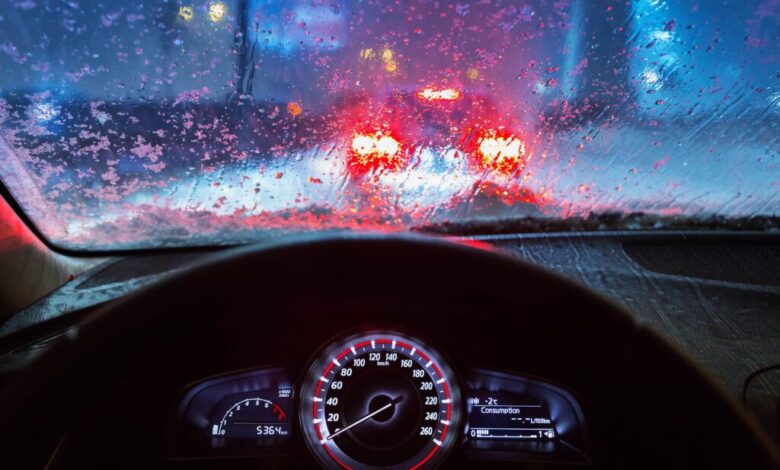A Guide to Driving Safely in Bad Weather

Driving in heavy rain, dense fog, or on slick, icy roads can be hazardous. Each year, bad weather contributes to numerous traffic accidents, many of which are preventable. Knowing how to adapt to these conditions with the right preparation and driving techniques is crucial for your safety and the safety of others.
Prepare Your Vehicle Before the Storm Hits
The first step to safe driving in bad weather is ensuring your vehicle is in optimal condition. A proactive check can make a significant difference when you’re caught in a storm.
Check Your Tires
Your tires are the only part of your car that connects with the road, making them critical for maintaining traction.
- Tire Pressure: Under-inflated or over-inflated tires can affect handling and grip. Check your tire pressure regularly, especially when temperatures change, as this can cause pressure to fluctuate. You can find the recommended pressure for your vehicle on a sticker inside the driver’s door jamb.
- Tread Depth: Adequate tread depth is essential for channeling water, snow, and slush away from the tire’s surface. You can check the tread with a penny. If you can see all of Abraham Lincoln’s head when you insert the penny upside down, it’s time for new tires.
Ensure All Lights Are Working
Visibility is key in poor weather, both for seeing the road and for being seen by other drivers. Walk around your vehicle and check that all lights are functioning correctly.
- Headlights, Taillights, and Brake Lights: Make sure these are all working and clean. Dirty or foggy headlight covers can significantly reduce the amount of light that gets through.
- Turn Signals and Hazard Lights: These are your primary way of communicating your intentions to other drivers, so ensure they are bright and operational.
Top Off Essential Fluids
Your car relies on several fluids to run smoothly. Keeping them at the correct levels is important for performance, especially in extreme temperatures.
- Windshield Wiper Fluid: You’ll use this frequently in rain and snow to clear your view. Use a fluid rated for cold weather to prevent it from freezing in winter.
- Antifreeze/Coolant: This prevents your engine from overheating in the summer and freezing in the winter. Check the level in the reservoir and top it off if necessary.
- Oil: Engine oil is vital for lubrication. Ensure your oil level is within the recommended range on the dipstick.
Driving Techniques for Different Conditions
Once your vehicle is prepared, you need to adjust your driving style to match the weather. The core principle for all conditions is to slow down and give yourself more space.
Driving in Rain
Rain is one of the most common forms of bad weather, and it presents several dangers.
- Reduce Your Speed: Wet roads significantly increase your vehicle’s stopping distance. Drive slower than the posted speed limit to give yourself more time to react.
- Increase Following Distance: Double your normal following distance from three seconds to at least six seconds. This provides a larger safety cushion if the car in front of you brakes suddenly.
- Avoid Hydroplaning: Hydroplaning occurs when your tires lose contact with the road and skim on a layer of water. To avoid it, slow down, avoid puddles, and drive in the tracks of the vehicle ahead of you.
Driving in Snow and Ice
Winter driving requires extreme caution, as traction can be minimal.
- Drive Slowly and Smoothly: Accelerate and decelerate slowly. Apply the gas gradually to regain traction and avoid skids. When stopping, allow for much more time and distance.
- Avoid Sudden Movements: Abrupt turns, braking, or acceleration can cause you to lose control. Make all your inputs gentle and deliberate.
- Don’t Stop if You Can Avoid It: If you can slow down enough to keep rolling until a traffic light turns green, do it. It takes much more inertia to get started from a full stop on ice than it does to keep moving.
Driving in Fog
Fog can reduce visibility to near zero, making it one of the most dangerous weather conditions to drive in.
- Use Your Low Beams: Use your low-beam headlights. High beams will reflect off the fog and create glare, making it even harder to see. If you have fog lights, use them.
- Stay Alert and Minimize Distractions: Turn off the radio and listen for traffic you cannot see. Open your window slightly to hear better.
- Follow the White Line: Use the white line on the right side of the road as a guide to help you stay in your lane.
What to Do in an Emergency
Even with careful preparation, you might find yourself in a tricky situation. Knowing how to react can prevent an accident.
If You Start to Skid
A skid happens when your tires lose their grip on the road.
- Steer in the Direction of the Skid: If the rear of your car is skidding to the right, gently steer to the right. This is often described as “steering into the skid.”
- Don’t Slam on the Brakes: If your car has an anti-lock braking system (ABS), apply firm, steady pressure. If it doesn’t, you may need to pump the brakes gently. Look where you want to go, not at what you’re trying to avoid.
If You Lose Visibility
If rain, snow, or fog becomes so heavy that you can’t see, the safest thing to do is get off the road.
- Pull Over Safely: Signal your intention, pull as far off the road as possible, and stop.
- Turn on Your Hazard Lights: This will make your vehicle more visible to other drivers.
- Wait It Out: Stay in your vehicle with your seatbelt on until the weather improves and visibility is restored.
Advanced Skills for Safer Driving
For those who want to take their driving skills to the next level, consider enrolling in a specialized course. Programs like defensive driving courses, like those offered in Utah, are designed to teach drivers how to anticipate dangerous situations and avoid accidents before they happen. These courses provide hands-on training and advanced techniques that can be invaluable in bad weather.
Conclusion
Driving in bad weather doesn’t have to be a stressful experience. By preparing your vehicle, adjusting your driving techniques, and knowing how to handle emergencies, you can significantly reduce your risk.



